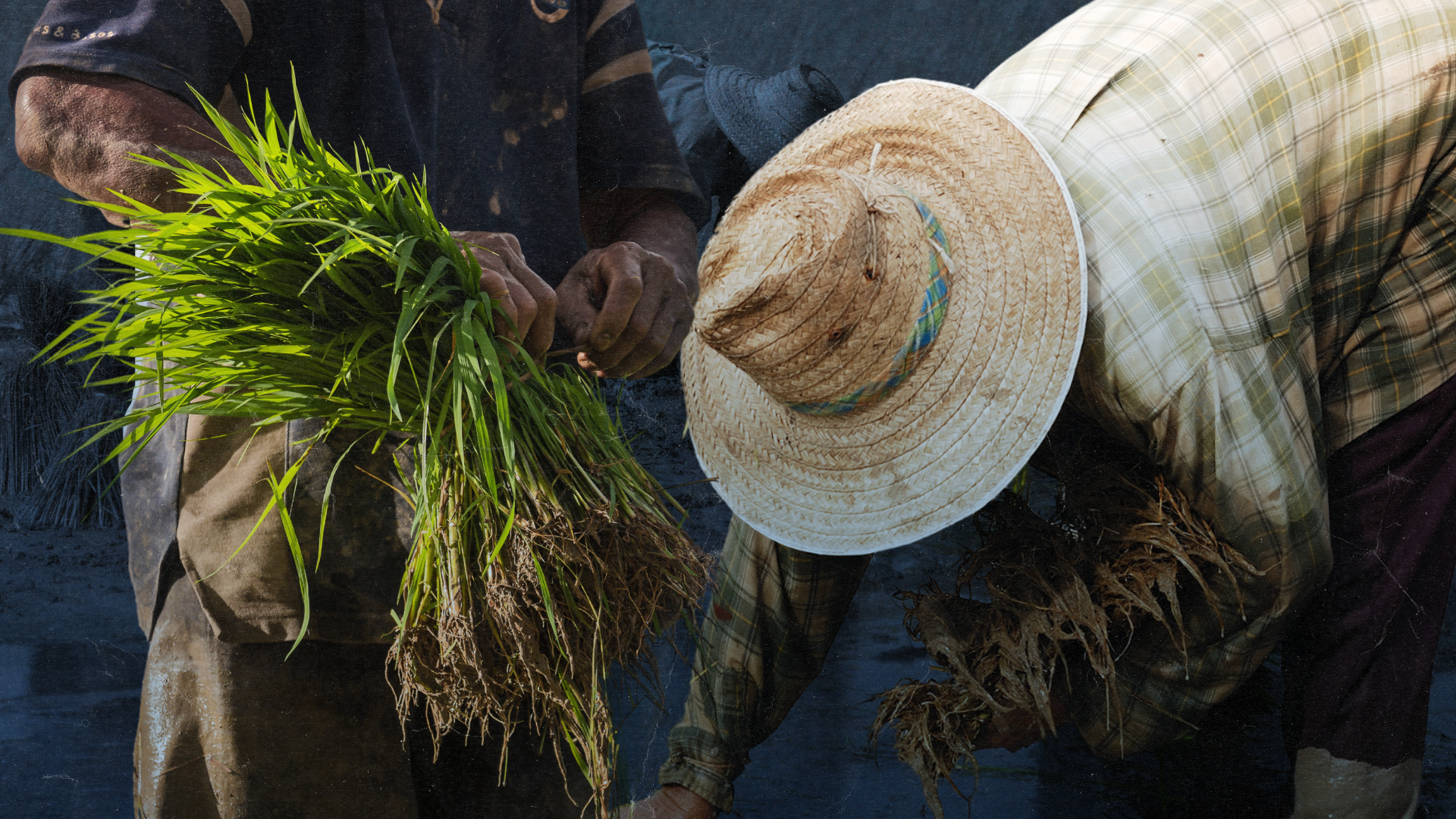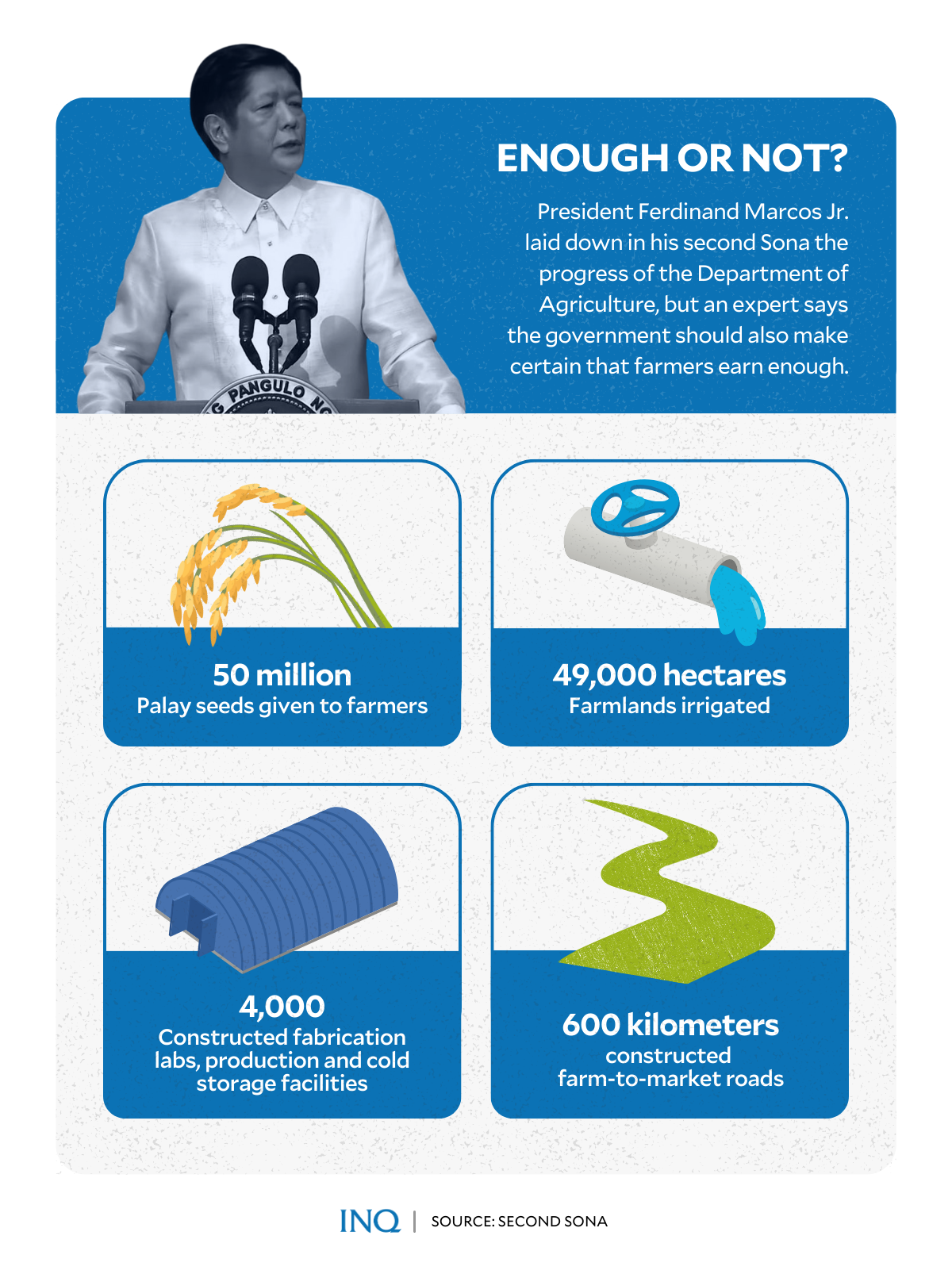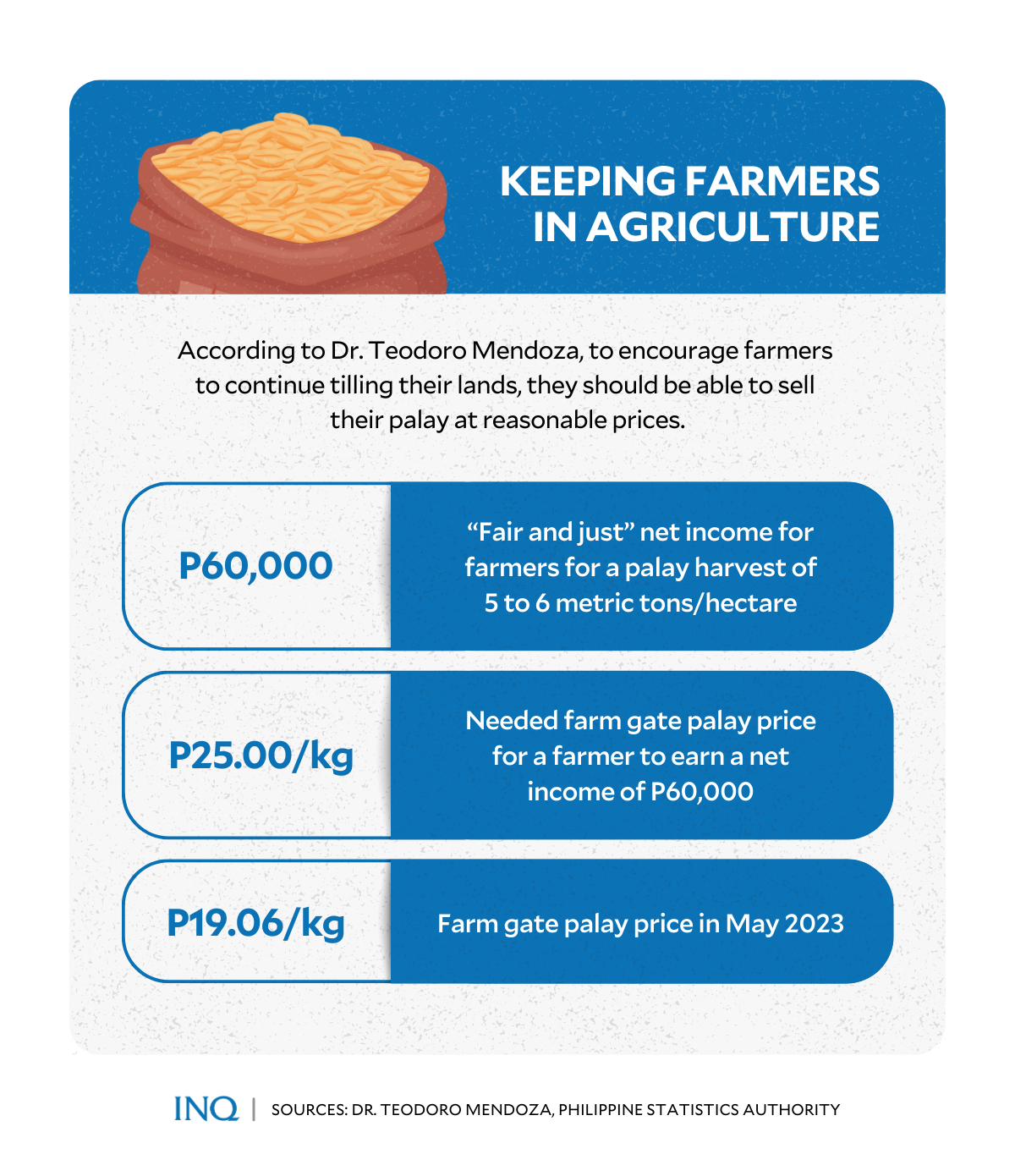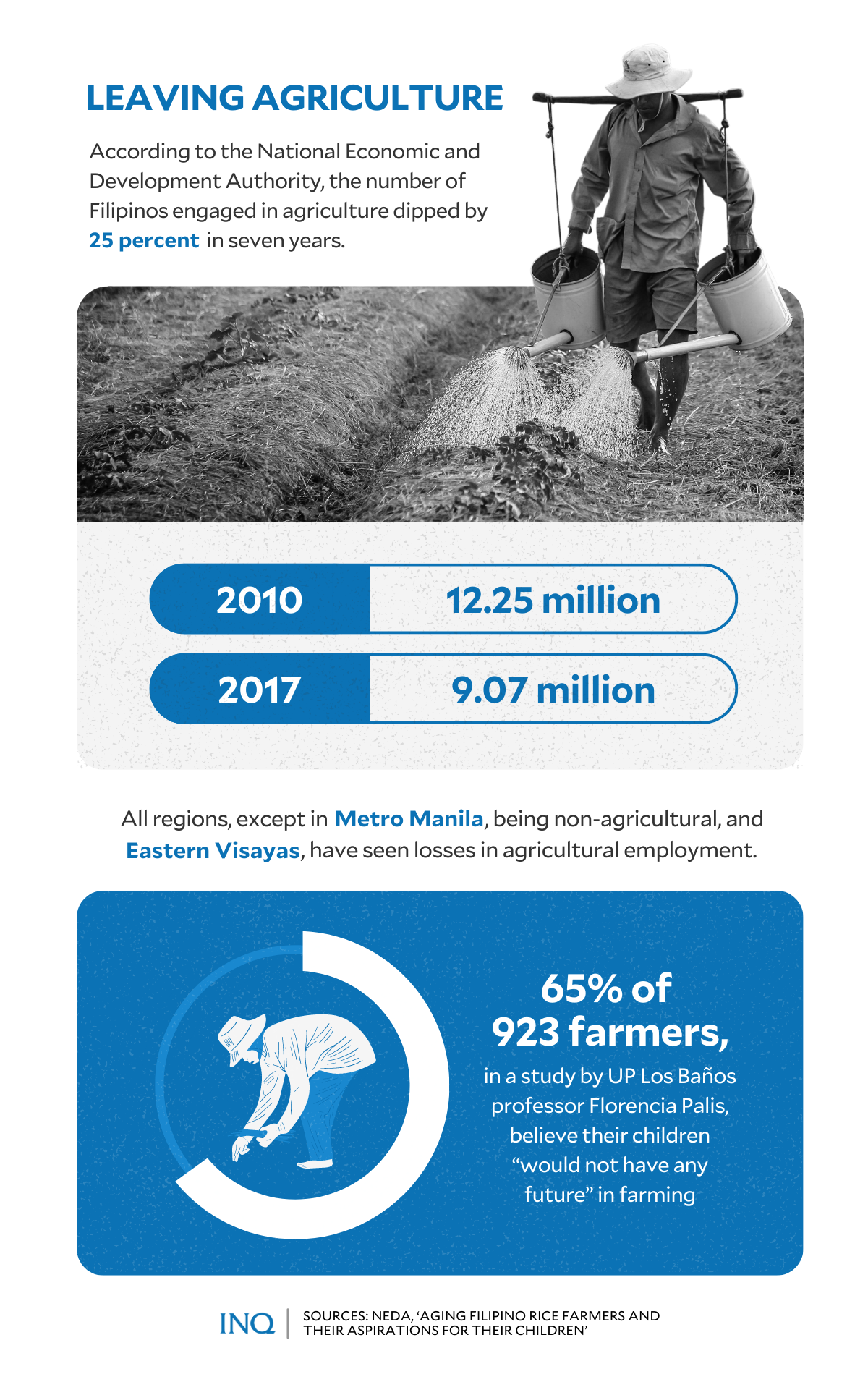Farmers missing in equation as gov’t aims for higher agri yields
MANILA, Philippines—As President Ferdinand Marcos Jr. addressed Filipinos in his second State of the Nation Address (Sona) last July 24, he dedicated nearly 30 paragraphs to one of his biggest promises—boost agricultural production.
Marcos, who had designated himself as agriculture secretary, said he knew the path the country should take toward improved agricultural yields—“consolidation, modernization, mechanization and improvement of value chains.”
These, he said, should be “augmented by timely and calibrated importation, as needed.”
But Dr. Teodoro Mendoza, a retired professor of crop science at the University of the Philippines (UP) Los Baños, said that he would continue to give Marcos a grade of “incomplete” in agriculture.
In his second Sona, Marcos listed the numbers that he said would show an improvement in agriculture—growth in production of 2.2 percent in the first quarter of 2023 from 0.2 percent decline in the first quarter of 2022, the last remaining days in office of then President Rodrigo Duterte.
Article continues after this advertisementREAD: Marcos lays out plans to ensure food security
Rice production, Marcos said, carried the torch growing by 4.5 percent in the same period.
Article continues after this advertisementIn the last year, according to Marcos, 600 km of farm-to-market-road and 4,000 fabrication labs and cold storage facilities had been built. The list continued with 49,000 hectares of farm irrigated and 50 million rice seeds distributed to farmers.
Mendoza, however, told INQUIRER.net via FB Messenger call on Monday (July 31) that while working on boosting production, Marcos “should make sure, too, that farmers will have a fair and just income.”
According to data from the Philippine Statistics Authority (PSA), palay production grew by 2.6 percent year on year to 5.02 million metric tons in the first quarter of 2023 from 4.90 million metric tons a year ago.
However, the farm gate price of a kilo of palay is still low at P18.57 in March, P18.79 in April, and P19.06 in May, way lower than the P25 that Mendoza is proposing for a kilo of the agricultural product.
“There was an increase in production, but the farm gate price is still low. What will happen to our farmers? They will gain nothing for everything they have worked hard for in the past crop cycle,” he said.
READ: Dwindling Filipino farmers
Fair, reasonable income
According to Mendoza, to encourage farmers to continue tilling their lands, the government should work on a better farm gate price of at least P25 per kilo.
At this price, a farmer can earn a net of P60,000 for a harvest of five to six metric tons per hectare, Mendoza said. If the average farm size is 1.4 hectares, this means farmers can earn as much as P84,000 per hectare.
According to data that Mendoza previously provided, the cost of production for the rice variety Rc222, which is arranged 20 centimeters by 20 centimeters, is almost P75,000. Expected to yield 6,110 kilos of palay, the gross income could be over P150,000.
However, with the current buying price of P19.06 a kilo, a farmer’s harvest can only translate to P116,000, leaving him or her a net income of P41,000, which is “clearly not enough” to provide for the household’s needs and to prepare the land for the next crop cycle.
Mendoza, a UP scientist, said that “if farmers are not earning, or are not receiving fair and just price[s] for their palay, they will not be motivated to grow and produce rice for us.”
A farm gate palay price of P25, however, would increase the cost of rice to P50 a kilo. According to DA’s Bantay Presyo as of July 31, a well-milled local commercial rice is now worth P41 to P49.
‘Dwindling’
Mendoza said when working on boosting production, the government should ask, too: “Will farmers earn a fair reasonable income? Because if not, farmers will no longer believe the government and they will be discouraged to produce more.”
This, as he pointed out that when farmers are asked to produce more to meet demand, their cost of production, including labor, services, rent, and farm inputs, like fertilizers, will get higher, too.
“They will be afraid they will not recover their capital,” he said, as he stressed that a lot of farmers are already getting old, while their children do not want to engage in farming since “they do not want to suffer the same fate as their parents.”
As previously stated by the National Economic and Development Authority, the number of Filipinos engaged in agriculture fell by 25 percent in seven years from 12.25 million in 2010 to 9.07 million in 2017.
READ: Where have PH farmers gone? Neda tracks 7-yr dip in agri labor
It said all regions, except Metro Manila, being non-agricultural, and Eastern Visayas, have seen losses in agricultural employment in the said period. Eastern Visayas increased its agricultural workforce by only 4.73 percent.
Then based on the study “Aging Filipino Rice Farmers and Their Aspirations for Their Children,” which was conducted by UP professor Florencia Palis, 65 percent of 923 farmers surveyed believed that their children “would not have any future” tilling land.
READ: Study affirms rural reality: Farmers don’t wish same hard life for kids
Scrap RTL
So what should the government do?
Mendoza said: “There is a need to amend the RTA or pass a new law about rice.”
The RTA, or the Rice Tariffication Act, which was signed into law in 2019, reduced the National Food Authority’s (NFA) role to one that maintains a 15 to 30-day buffer stock of rice from palay bought from local producers.
“Now, if the government will heed my recommendation for the NFA to increase its buffer stock and buy palay at P25 a kilo, private traders will have no choice but to compete and raise their buying price, too,” he said, stressing that “through this, the government can intervene.”
He said on the average, the buffer stock should at least be 60 days.
“If the government will raise the buying capacity of the NFA by passing a new law, the farm gate palay price will increase, too,” he said as he pointed out that “there are a lot of things that should be considered when trying to achieve food security.”



